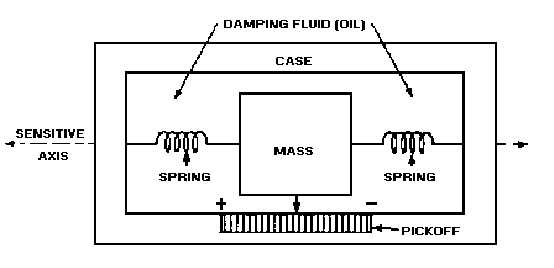3-21
Figure 3-20.—The basic accelerometer.
An accelerometer is sensitive to gravity when its sensing axis is positioned so gravity can move or
attempt to move the mass. This is useful in that we can use gravity as a reference for testing purposes, but
it can be a serious problem because of the errors it may cause in acceleration measurements. If the unit is
placed with the sensing axis vertical, the mass will be displaced such that the output is one "G," or one
unit of gravity. This is done during testing. Then when the sensitive axis is turned so it is horizontal to the
Earth, the springs center the mass, and the output of the unit is zero.
E-TRANSFORMER ACCELEROMETER
The E-transformer accelerometer (fig. 3-21) consists of a mass suspended from a calibrated leaf
spring in a manner similar to a pendulum. The mass is effectively the armature of an E-transformer of the
type used as an error detector in a servo system. The mass of the accelerometer is enclosed within a case
that is filled with a damping liquid, which helps keep the pendulum from oscillating. The accelerometer is
mounted so that acceleration in only the desired geometrical plane is detected.
Figure 3-21.—E-transformer accelerometer.



